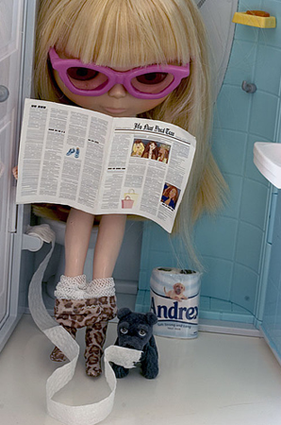Life Cycle is a series of posts on the extraordinary journeys of everyday things.

After the coffee, paper and cig, our morning ritual continues in the loo.
What you may not realize, cherie, is that whatever you flush down comes back around. Our waste fertilizes our fields and is pumped back into the waterways that are our major sources of drinking water. Let's take the journey from toilet to tap, shall we? Oui oui. (We're affecting French here for a touch of sophistication in a post centering on fecal matter.)
Americans use about 70 gallons of water indoors, every day. About three-quarters of that is used in the toilette--shower, bath, sink, crapper--and over one-quarter is used whisking away our waste. You can cut this water usage by making sure your toilet isn't leaking, using a composting or low-flow toilet or even displacing the water in the tank with a brick or container filled with sand. Your toilet is not a trashcan, so save cigarette butts, tissues and used condoms for the basket, not the bowl.
We don't want to bum you out, but cutting water usage means a lot in an era when more than a billion people lack access to safe drinking water. According to Claudia McMurray, U.S. Assistant Secretary for Oceans and International Environmental and Scientific Affairs, "On any given day, approximately 50% of the world's hospital beds are filled with patients suffering from water and sanitation related diseases. Each year 1.8 million children in developing countries die from diarrheal disease--the second leading cause of death after pneumonia."
When aiming for more equitable water usage, hippie wisdom comes in handy: If it's brown flush it down; if it's yellow, let it mellow. S'il vous plait. (Our hippie is French.)
After the solid and liquid waste leave the bowl, they're routed through your house pipes to what's called a sanitary sewer. This is where the magic happens. Your precious cargo arrives at the treatment plant and passes through a series of mechanical screens. The solids get sent to a landfill, while the smaller bits get separated into sludge and liquid waste.
During secondary treatment, the sludge is pumped into concrete digesters where oxygen-hungry bacteria chomp on our crap and break organic sewage into simpler inorganic compounds. This concoction is drained, and the dehydrated "bio-solids" are sent to farmers to use as fertilizer on our fields. Unfortunately, these refined poo pellets contain heavy metals, dioxins, PCBs, pesticides and hundreds of other toxic chemicals. They pollute surface water and cause rashes and infections in farmers and livestock. Not surprising, the use of fecal fertilizer is causing shitstorms all over the place. Some green groups maintain that with better safeguards, sludge might be one of the best ways to handle our waste, but until there's better oversight, you may want to seek out certified organic produce grown without bio-solids.
Back in the sewage treatment plant, the remaining water is disinfected chemically and discharged into a stream, river, lagoon or wetland or used for irrigation on golf courses or highway medians. Despite being chemically treated, that water is still rife with birth-control, anti-depressants and other pharmaceuticals we once ingested and wee-weed out. Sources of drinking water like the Puget Sound and the Potomac River harbor trace amounts of caffeine, heart medication, estrogen and more.
What are we to do? Don't flush your drugs, for starters. And rejoice in the fact that scientists have now developed a way to turn pee into electricity, sprinkling a few drops onto copper chloride paper and generating about 1.5 volts of energy.
One more suggestion that will lighten the load: Get yourself a bidet (those French!) or use recycled toilet paper. Recycled, mon ami, not reused. The average American uses over 100 rolls a year, most of which is made from a combination of softwood and hardwood trees--Southern pines and Douglas firs make the paper strong, while maples and oaks make the paper soft. Zut alors! Oak trees have been felled to give our asses a little more comfort! And to ease our eyes, the paper is brightened with chlorine bleach which results in dioxin contamination. T.P. made from recycled paper uses colored and white stock (with staples and pins removed, natch) and is usually whitened with hydrogen peroxide.
C'est bon.
Next: La douche! (As in French for "the shower," not your mom's Summer's Eve.)
This post was written by Simran Sethi and Sarah Smarsh. Thanks to the University of Kansas School of Journalism and Lacey Johnston for research assistance. Photo courtesy of Gothelina.